In today’s rapidly urbanizing world, open spaces are becoming more of a luxury than a given. Many of us find ourselves tucked into cozy apartments or homes with tiny yards, making traditional gardening seem like a far-off dream.
However, human ingenuity knows no bounds, especially when it comes to adapting and overcoming challenges. This is precisely where the brilliance of vertical pallet gardens comes into play.
For those unfamiliar with the concept, imagine a lush, green, vertically standing garden housed within the wooden framework of an upcycled wood pallet.
These vertical gardens breathe life into a small space, making it vibrant and fresh, and exemplify the idea of sustainable living. By reusing old pallets, we are reducing waste and, at the same time, creating a thriving space for plants to grow.
The vertical pallet garden has emerged as a beacon of hope with rustic farmhouse appeal for urban dwellers or anyone with limited gardening space. It’s a testament to the possibilities that arise when we think outside the traditional gardening box—literally and metaphorically.
This is a great way to repurpose old pallets and a striking example of how upcycled wood pallets can be transformed into an eco-friendly, functional, and visually appealing gardening solution.
Whether you’re a seasoned gardener looking to try something new or a beginner seeking a manageable and space-efficient garden project, a vertical pallet garden offers many opportunities.
Let’s delve into the nuances of this innovative gardening method and discover how you can create your own oasis, even in the tiniest of spaces.
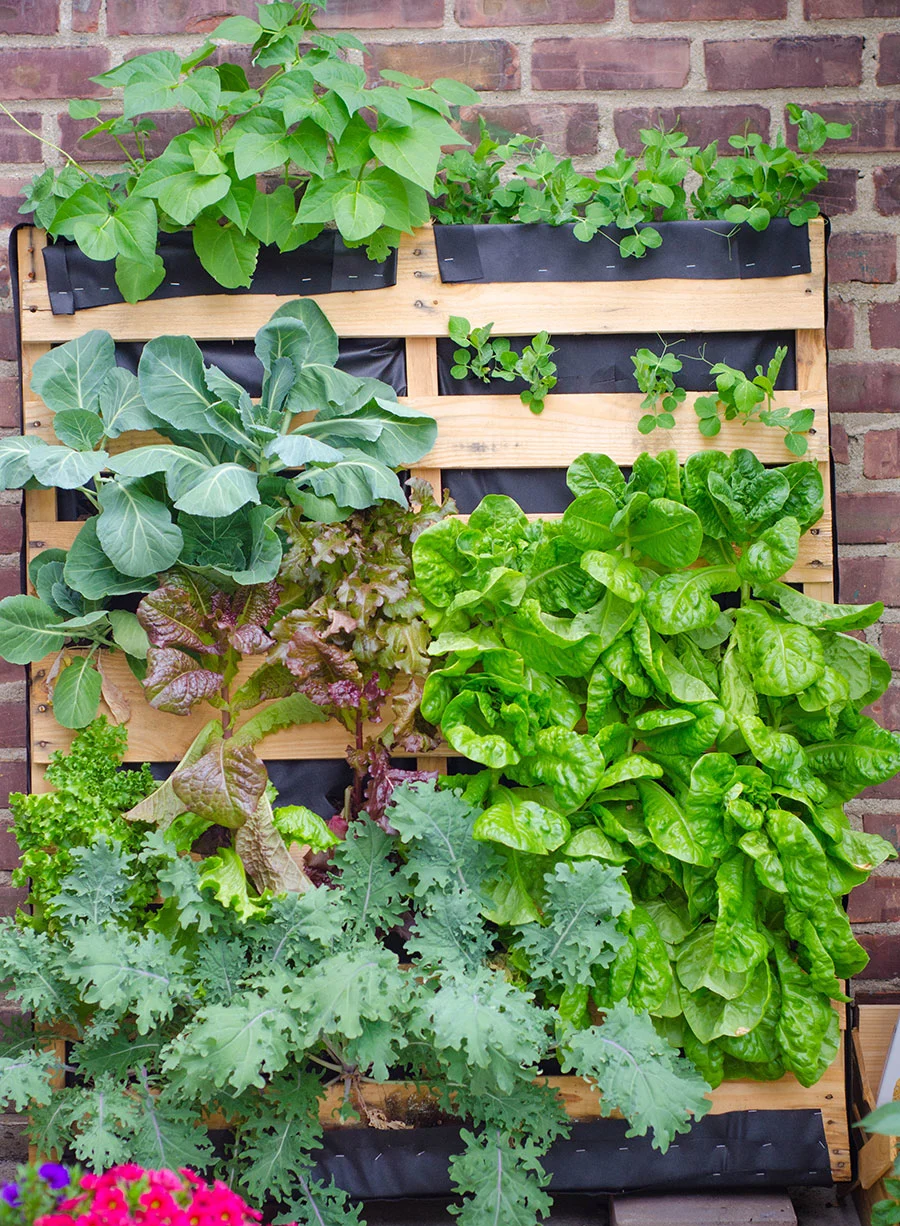
Basics of building a vertical pallet garden
Before diving headfirst into your vertical pallet garden project, laying down some groundwork is essential. One of the most crucial elements of this project is the pallet itself.
A common misconception is that any old pallet will do for gardening, but that’s far from the truth. The origin, condition, and especially the treatment of the pallet can play significant roles in the success and health of your garden.
Understanding how pallets are treated
Pallets are primarily used for transporting goods, and to ensure they don’t become a breeding ground for pests or diseases, they undergo various treatments. There are two main types of treatments: chemical and heat.
Chemical treatments, particularly those that use methyl bromide, are harmful to plants and humans. Using such pallets for gardening can leach toxic chemicals into the soil, posing health risks.
On the other hand, heat-treated pallets are a safer alternative. These pallets are treated using heat instead of chemicals to kill pests and diseases. It’s an environmentally friendly process, making these pallets ideal for gardening purposes.
Spotting the right pallet
To ascertain the type of treatment a pallet has undergone, look for the IPPC (International Plant Protection Convention) logo. This stamp means the pallet has undergone treatment to prevent the spread of pests. Near this logo, you’ll also find a treatment code:
- HT: Heat-Treated – This is the stamp you’re aiming to find. It indicates that the pallet underwent a heat treatment process and should be safe for gardening.
- MB: Methyl Bromide – Avoid pallets with this stamp, as it signifies the use of chemical treatment.
In addition to the treatment type, inspect the pallet’s overall condition. Opt for those in good condition that are clean, sturdy, and free from any visible mold, rot, or excessive wear.
A little time spent ensuring the quality and safety of your pallet can make all the difference in the success and longevity of your vertical garden.
Now, with a clear understanding of pallet treatments and having selected the right pallet, let’s move into the step-by-step process of building your vertical pallet garden.
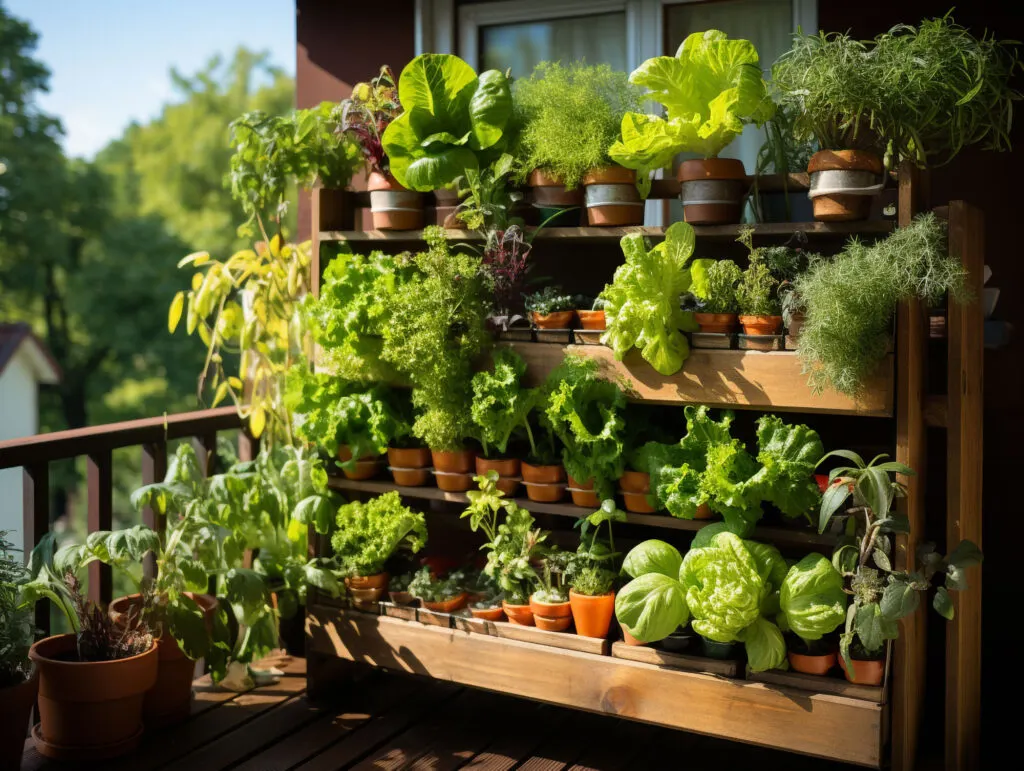
A step-by-step guide to building your vertical pallet garden:
Constructing a vertical pallet garden may seem like a straightforward endeavor—and in many ways, it is—but the difference between a flourishing garden and a lackluster one can often boil down to the details in its creation. Let’s delve deeper into each step, ensuring your garden starts on a strong foundation and thrives in the long run.
1. Preparation:
– Inspect and clean: Before starting, give your pallet a thorough once-over. Remove any errant nails or staples, and make sure it is in overall good condition. If your pallet has been sitting outside or in a warehouse for a while, there might be dirt or mildew. Give it a good scrub with soapy water and let it dry completely.
– Sanding: The rough surface of pallet wood can sometimes be a hazard. Using medium-grit sandpaper, sand down any rough spots or splinters. This makes your pallet safer to handle and gives it a neater appearance.
2. Adding the backing:
– Cutting the landscape fabric: Lay your pallet flat with the side you want to plant facing down. Roll out landscape fabric over the pallet and cut a piece that covers the entire back and at least six inches over the sides and bottom. This excess will help secure the fabric in place.
– Securing the fabric: With a staple gun, begin securing the landscape fabric to the pallet’s perimeter and back of the pallet. Ensure it’s taut as you staple to prevent sagging. Fold and staple the fabric at the corners, almost like you’re wrapping a gift.
Remember to double up on staples along the bottom of the pallet to ensure the weight of the soil won’t cause a breach. Now your pallet garden bed is ready to fill with soil.
As you are stapling on the fabric, you can create “pockets” for planting by securing the fabric to the bottom of each slat as you cover the back. Or, if your slats are close enough together, you can fill the entire pallet with soil.
If you will be using your pallet as a hanging planter, you can skip the landscaping fabric and soil.
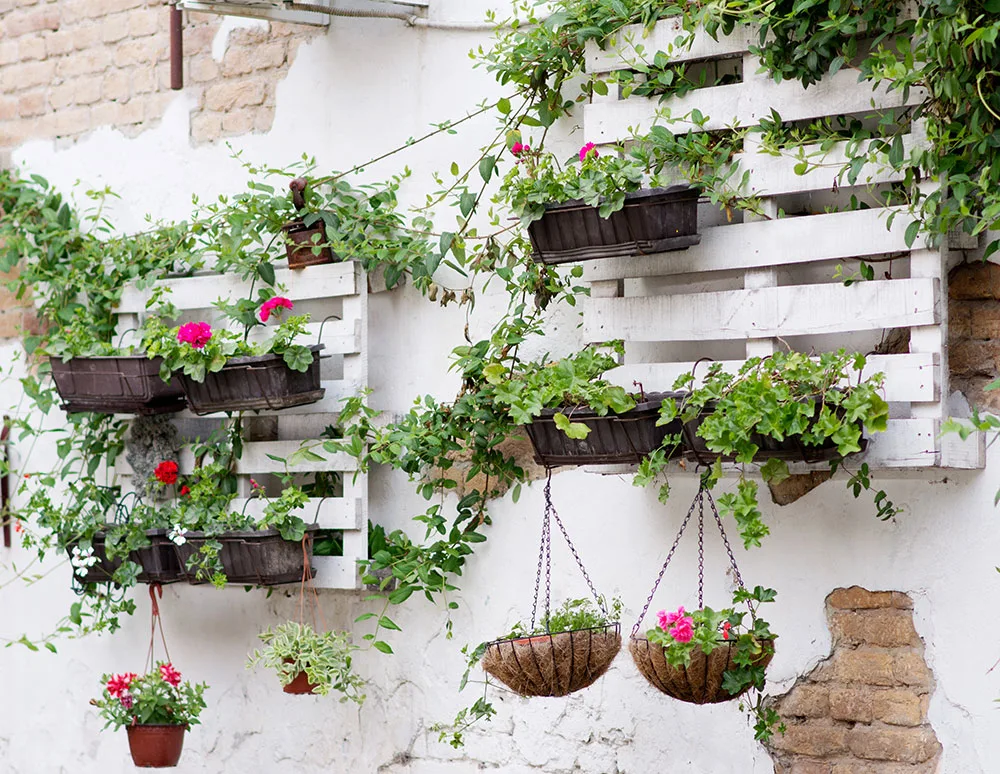
3. Filling it up:
– Soil selection: Opt for a high-quality potting mix with good drainage. Mix it with compost for added nutrients. Remember, the quality of the soil can make or break your garden.
– Adding the dirt: Lay the pallet flat and start filling in the spaces between the slats with your soil-compost mixture. Press down gently to ensure the soil is compact but not overly dense. This stage is also an ideal time to add slow-release organic fertilizers if you’re so inclined.
4. Planting:
– Choosing Plants: Decide what you’d like to plant. A pallet herb garden is a good idea if you want easy access to fresh herbs. You can also go for flowers, small veggies, or a mix of everything. Consider the sunlight your garden will receive and select plants accordingly.
The best plants will depend on several factors, including how much light and moisture your garden will receive.
– Spacing: When planting, ensure you give each plant enough room to grow. Check the plant tag (or seed packet, if starting from seeds) to get an idea of the mature size of each plant. Insert plants into the soil, ensuring their roots are adequately covered, and pat the soil down gently around the base of the plant.
– Watering: After planting, water your garden generously. This helps the plants settle and also reveals if there are any spots where the soil might spill out.
5. Positioning:
– Letting the Plants Root: If you fill your entire pallet with soil rather than creating pockets for planting, you’ll want to give the roots of the plants time to establish themselves and help stabilize the soil. This can take anywhere from one to three weeks, depending on the plants. During this rooting phase, make sure you water regularly.
– Positioning: Once the roots are established, carefully lift the pallet into its upright position. Ensure it’s stable—either by leaning it against a wall or using some form of support—to avoid any accidents. You don’t want all your hard work to come crashing down with the next big wind gust.
If you made pockets to plant in rather than filling the entire pallet with soil, you can carefully set your pallet upright immediately after planting.
By dedicating attention to each of these steps, you’ll set up your pallet vertical garden for success. With the right care, your garden will be a space-saver and a delightful centerpiece for your outdoor area.
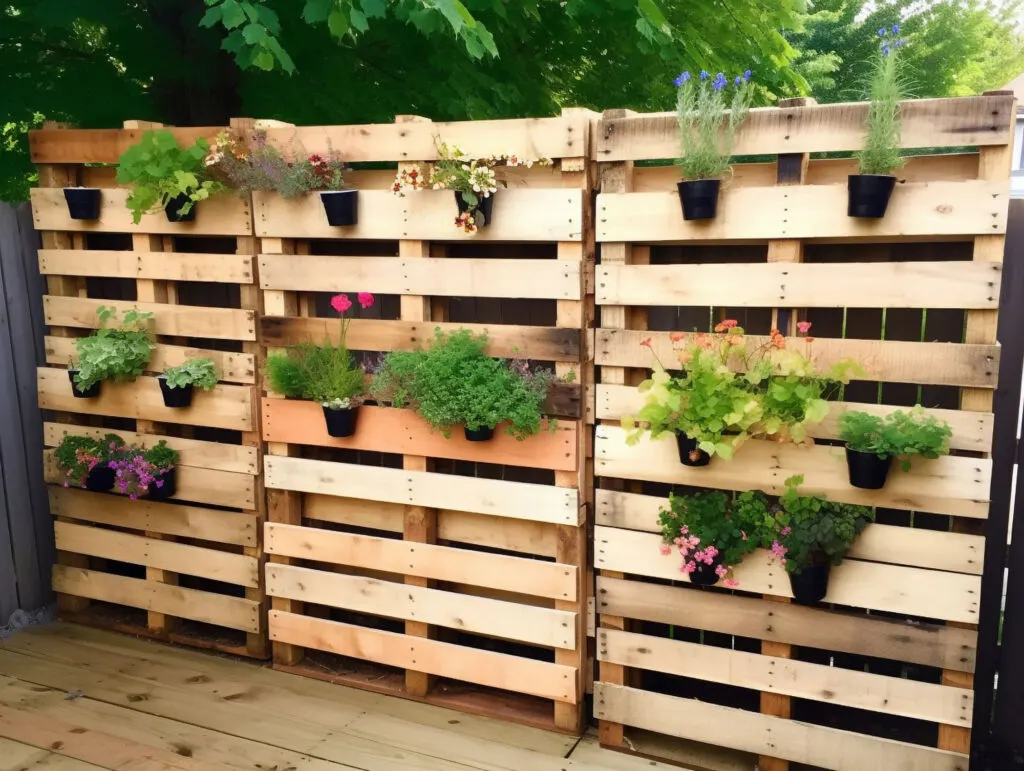
Alternative ways to use pallets for plants
For a quick and easy alternative to planting inside the pallet, consider using it as a rack for hanging plants. You can achieve this by screwing hooks into various places on the pallet from which planters can hang. Or you can use wire to secure planting pots to the slats and arrange them as you like.
This is a great way to utilize vertical space where you might not otherwise be able to and it doesn’t confine you to specific plants in specific places. You can move them around as they grow.
Vertical Pallet Garden Ideas
Creating a vertical planter using wooden pallets is just the beginning. There are numerous ways to enhance and personalize your garden. Here are some easy DIY pallet garden ideas to inspire you:
Vertical herb garden
As mentioned earlier, a vertical pallet planter makes an excellent herb garden. Painting your pallet with black chalkboard paint is a fun way to create a unique vertical planter that is easy to label – simply write the plant names right on the wood with chalk!
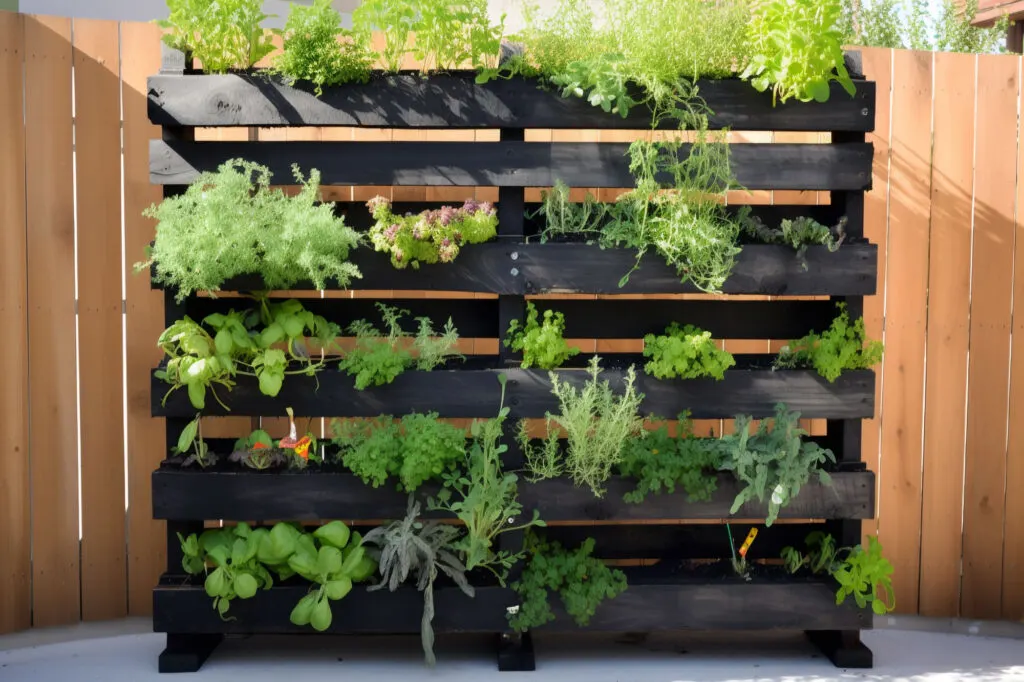
Most herbs are very forgiving and super easy to grow. We have unpredictable weather here, with short summers that could give us tons of rain for several days in a row, then nothing but heat and wind for weeks. No matter what nature throws at us, herbs are always the most resilient plants in my garden.
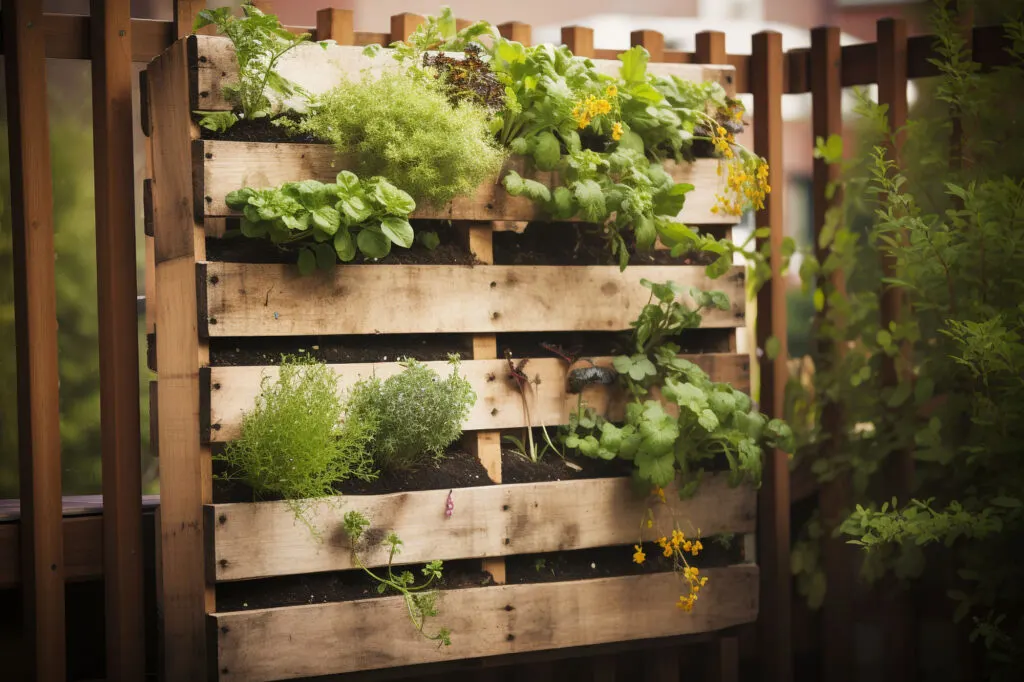
For the cook who loves variety and convenience, a pallet herb garden is a handy way to grow several types of herbs together while saving space.
Pallet garden wall
Instead of having a single vertical planter, why not create a garden wall? You can join multiple pallets together and create a spectacular green display on your property.
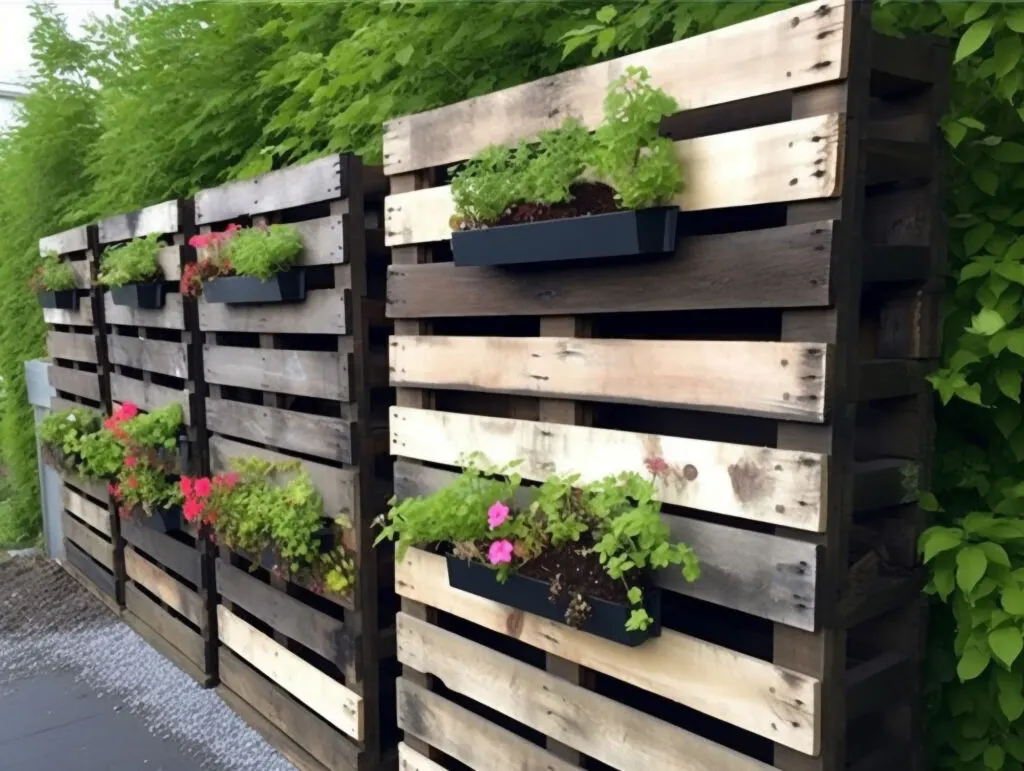
If you have a small yard or balcony, a pallet wall can double as a privacy wall and a planter – and they look really cool! This is creative upcycling at its best.
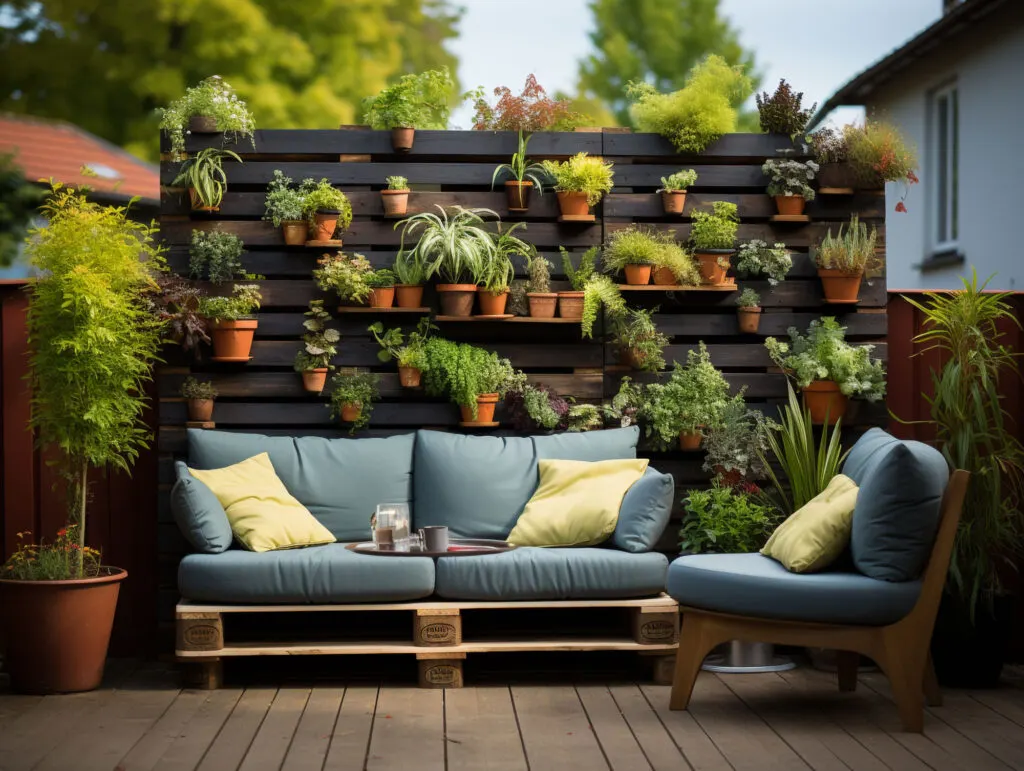
Pallet vegetable garden
If you’ve got a sunny spot, wooden pallets can be a great way to grow vegetables. It’s an easy way to have raised garden beds without the complexity of constructing them.
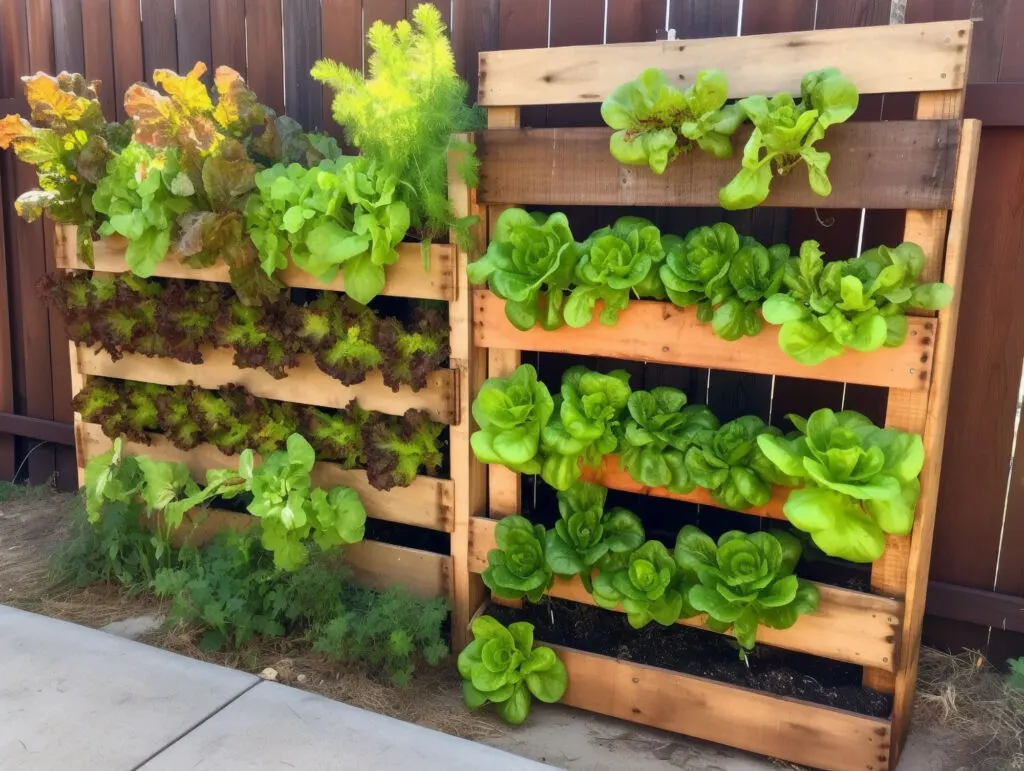
A pallet garden might be the ideal solution if you live in an area with little to no growing space. They fit just about anywhere – against a wall, next to a fence, or on a deck or balcony.
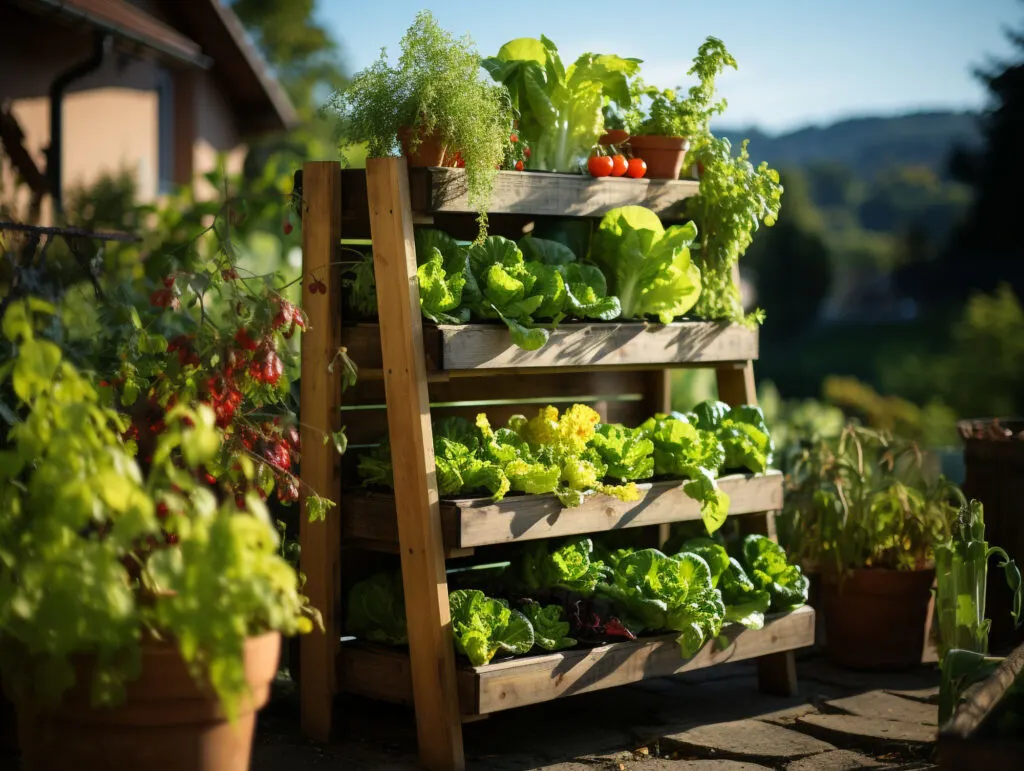
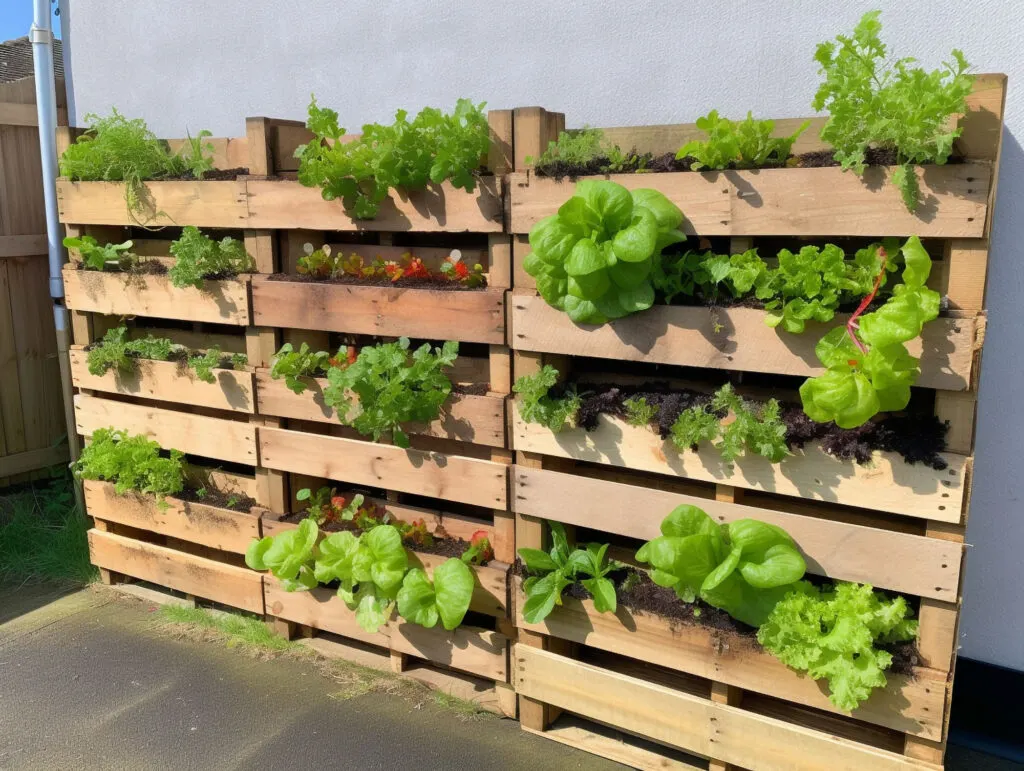
Pallet flower beds
Brighten up your space by turning the pallet into a bed for vibrant flowers. A flower garden is a fantastic way to add color and life to your garden or balcony. Annual flowers bloom all season long and are generally easy to care for.
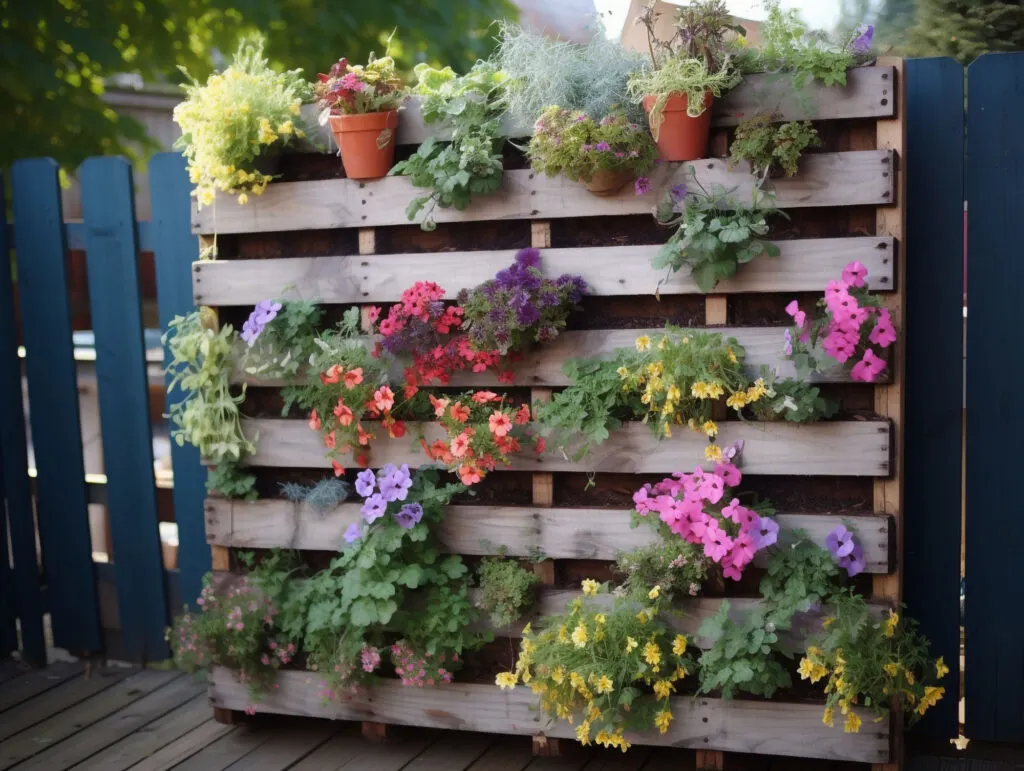
A pallet garden with annuals is a beautiful way to add a pop of color to your space that you can customize yearly. Choosing a color scheme for my planters is one of my favorite things to do every spring.
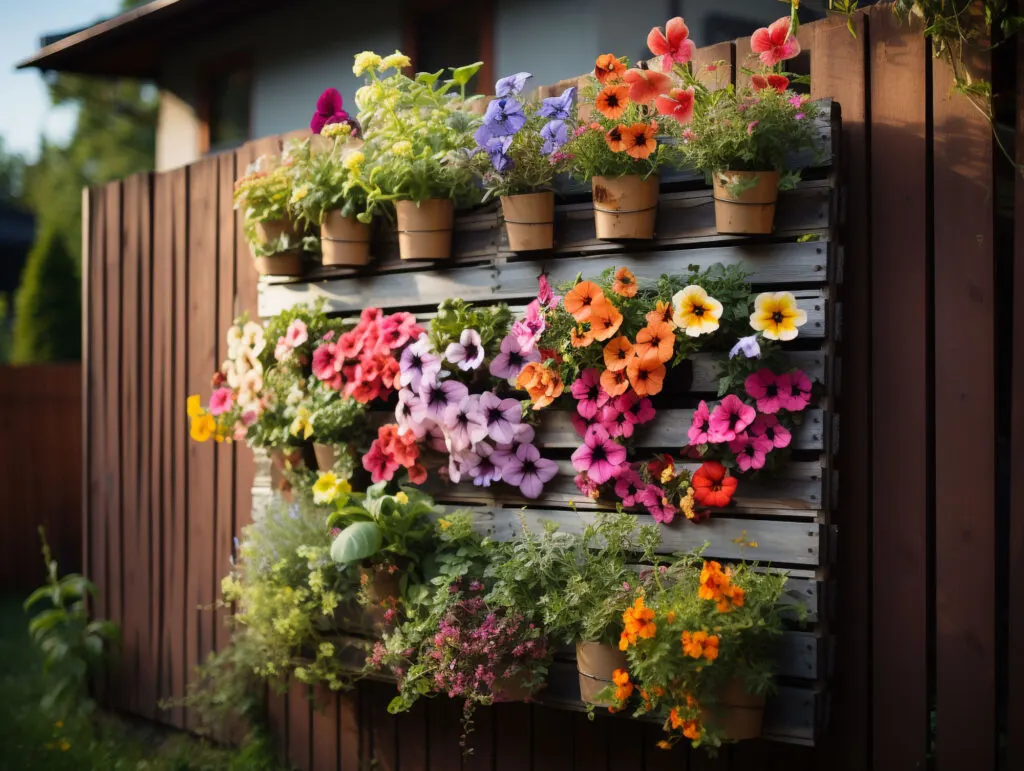
Balcony garden
Pallet planters make great balcony gardens because they are space-efficient and allow for a variety of plants to be grown in a small area.
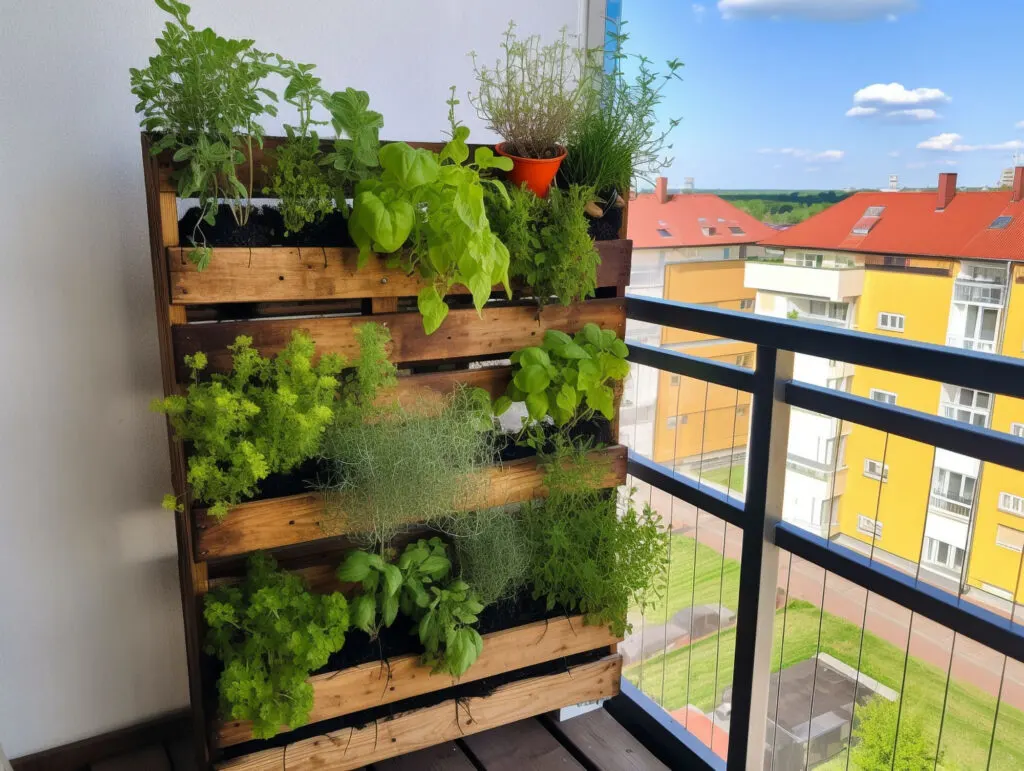
We say it all the time – don’t have growing space? Go vertical! A pallet garden can easily fit on most balconies and lean against a wall or railing.
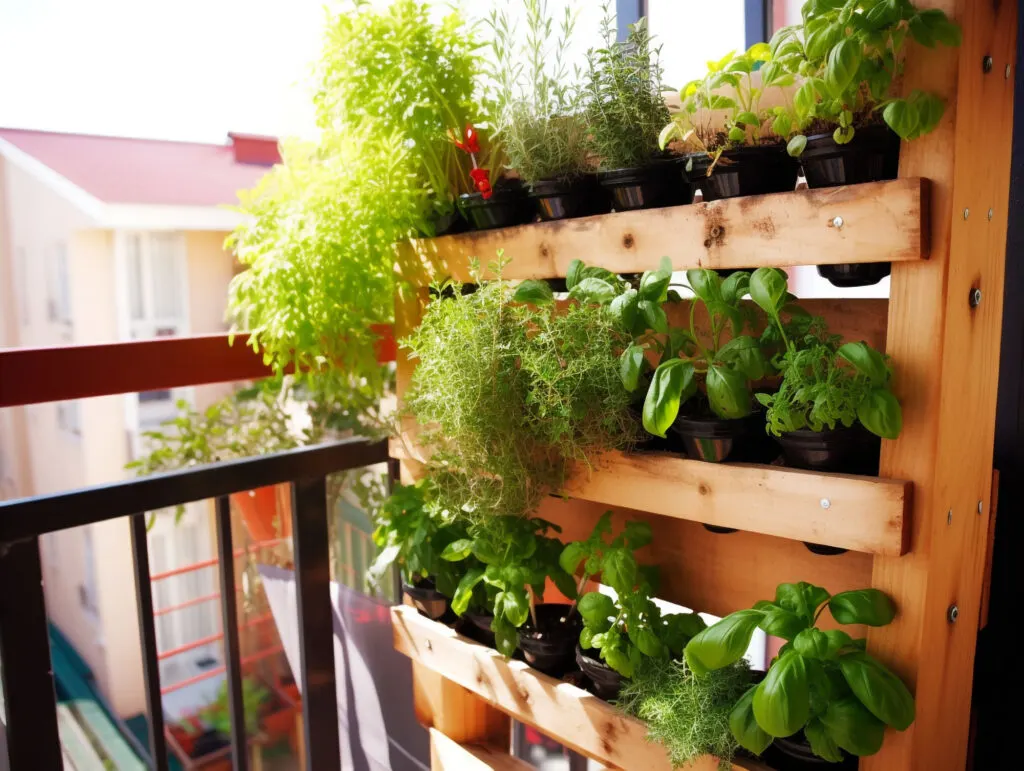
Colorful planters
Pallet gardens can be painted in unique and fun colors to add a personalized touch to your balcony or garden space.
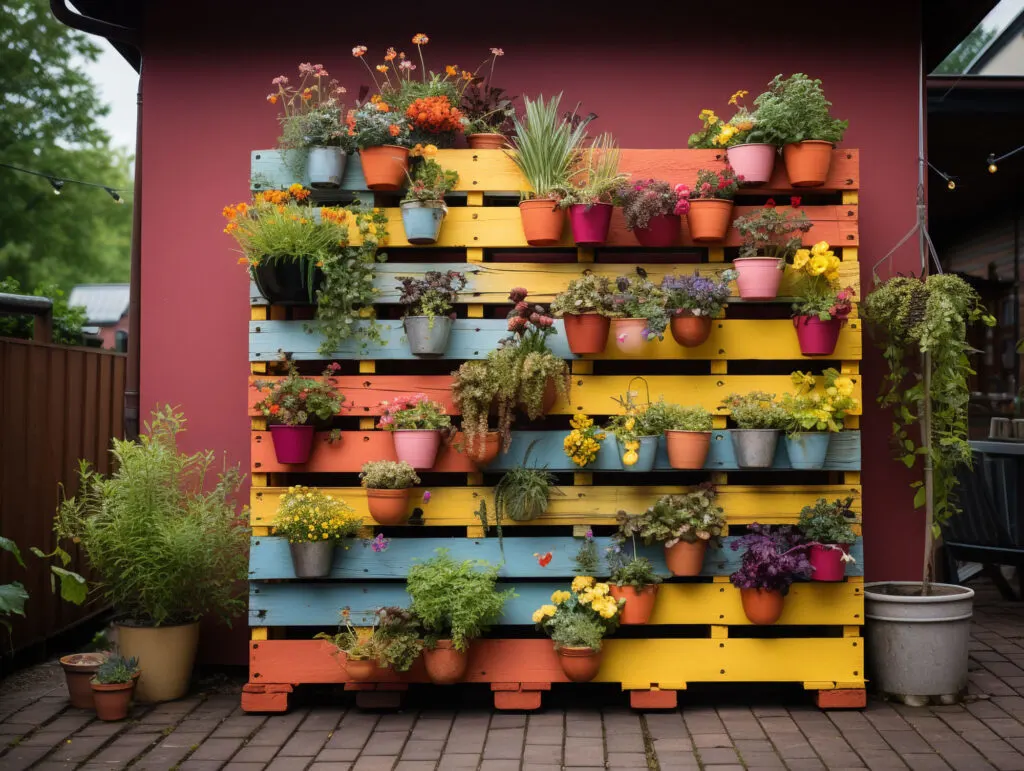
Painting pallets is a great project for kids! If you want to make it really fun and educational, let your kids have their own pallet garden to paint, choose plants for, and care for throughout the summer.
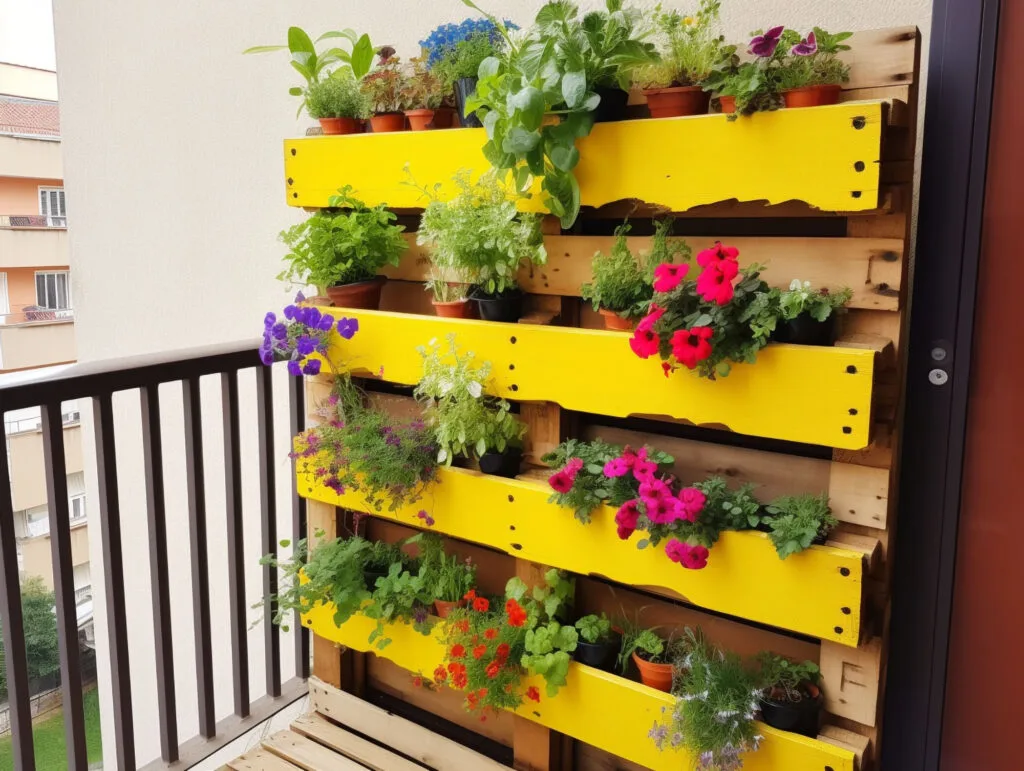
Planter boxes
One creative way to upcycle pallets is by transforming them into stylish and functional planter boxes for your plants. If you have the space, attach four pallets into a square, fill the middle with soil to build a raised bed for larger plants, and use the slats of the pallets as additional vertical planting areas.
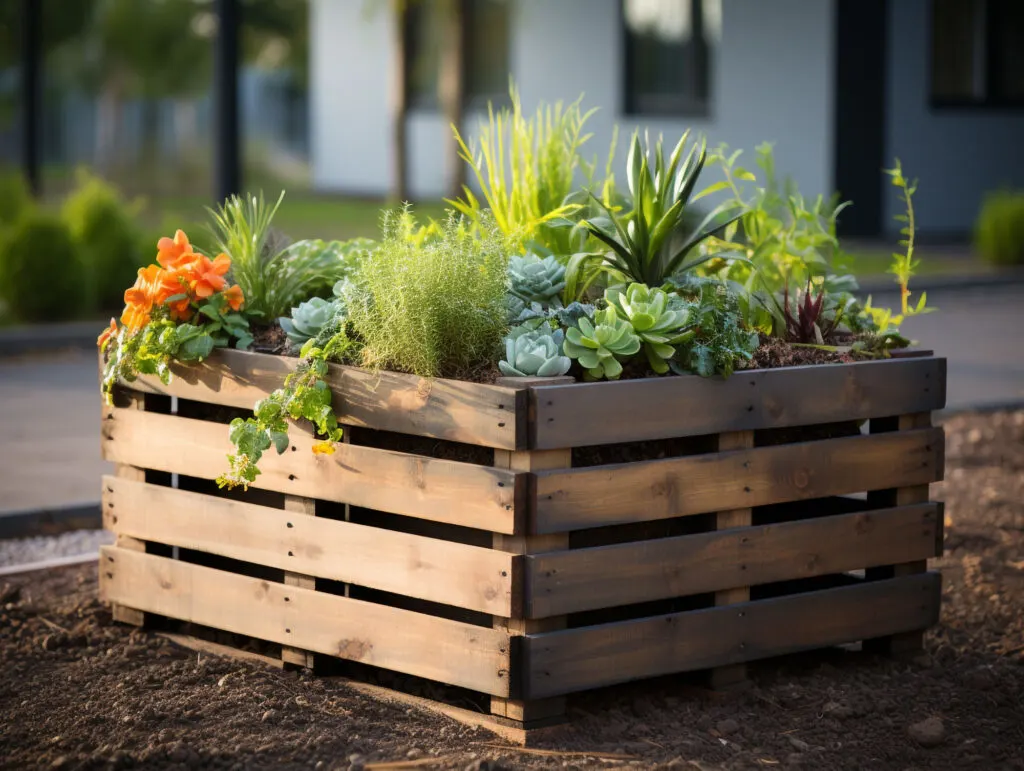
You’ll need to line the pallets with landscaping fabric to keep the soil from spilling out (especially during watering), but it’ll be worth the effort!
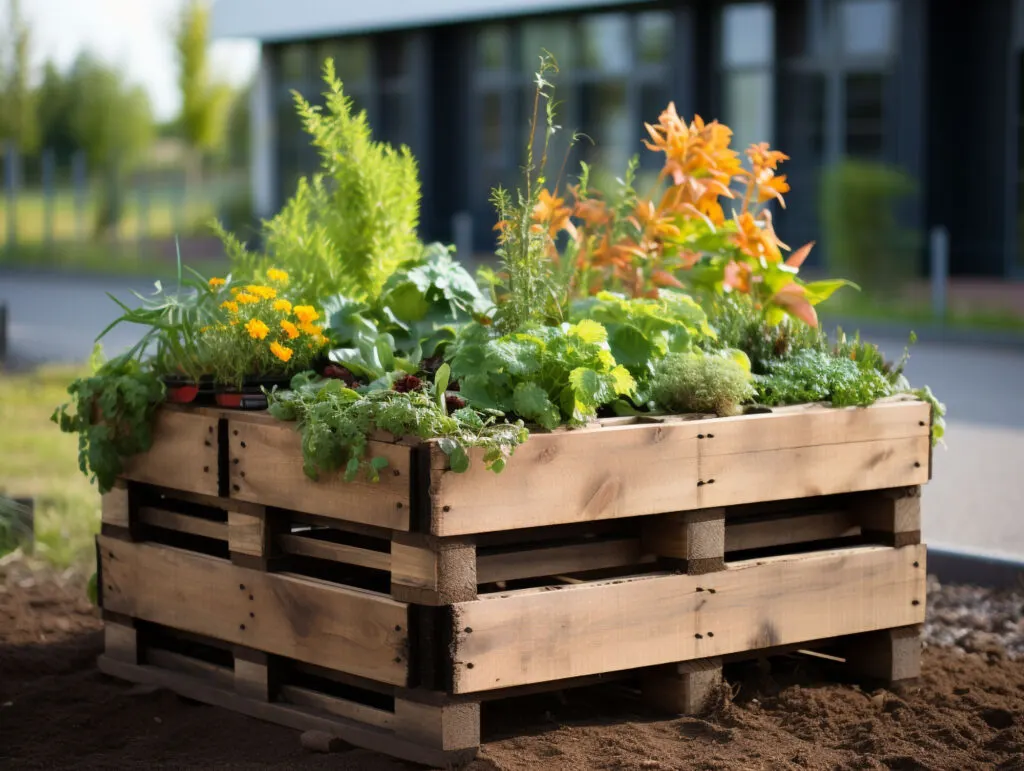
Pallet garden decor
Get artistic! Paint the wooden sections of the pallet or add decorative elements to turn your garden into a piece of art.
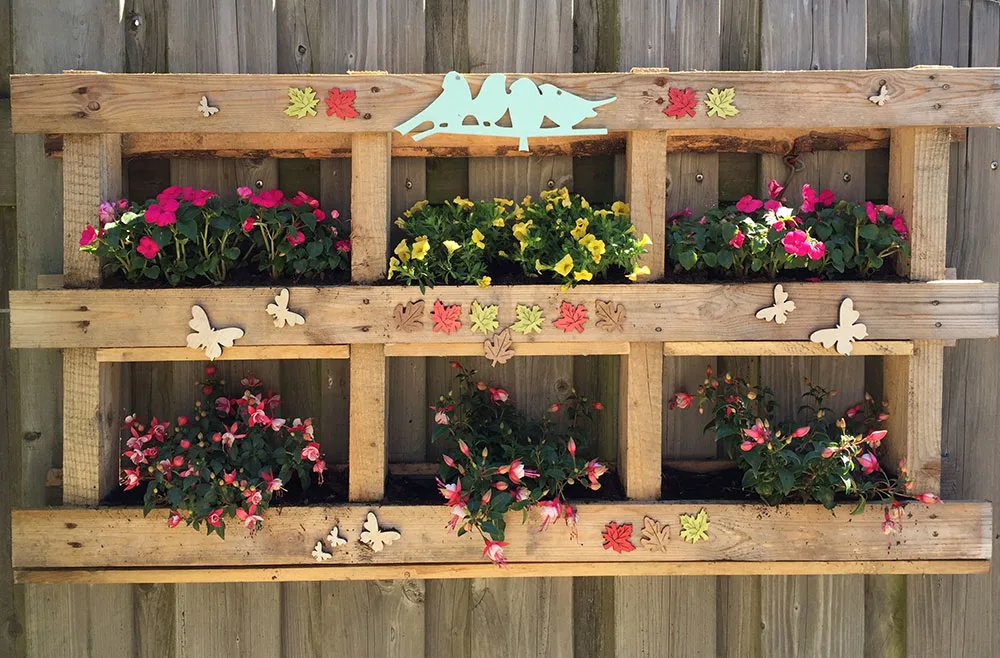

You can also incorporate pallet planters into other elements, like furniture. Try attaching a wooden bench to your vertical garden to hold potted plants or to use for outdoor seating.
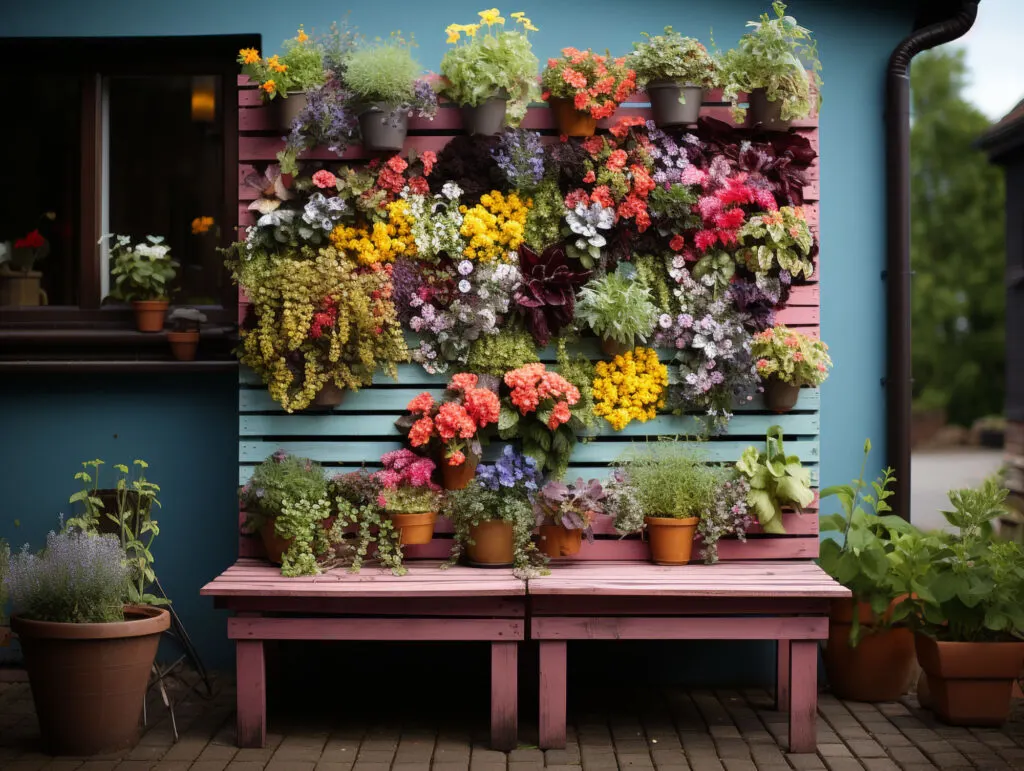
Hanging planters
As we mentioned above, another creative way to use pallets is to turn them into hanging planters. You can create a unique and eye-catching display for your plants by attaching hooks to the pallet and adding planters. Plus, the pallets provide a rustic and charming touch to any outdoor or indoor space.
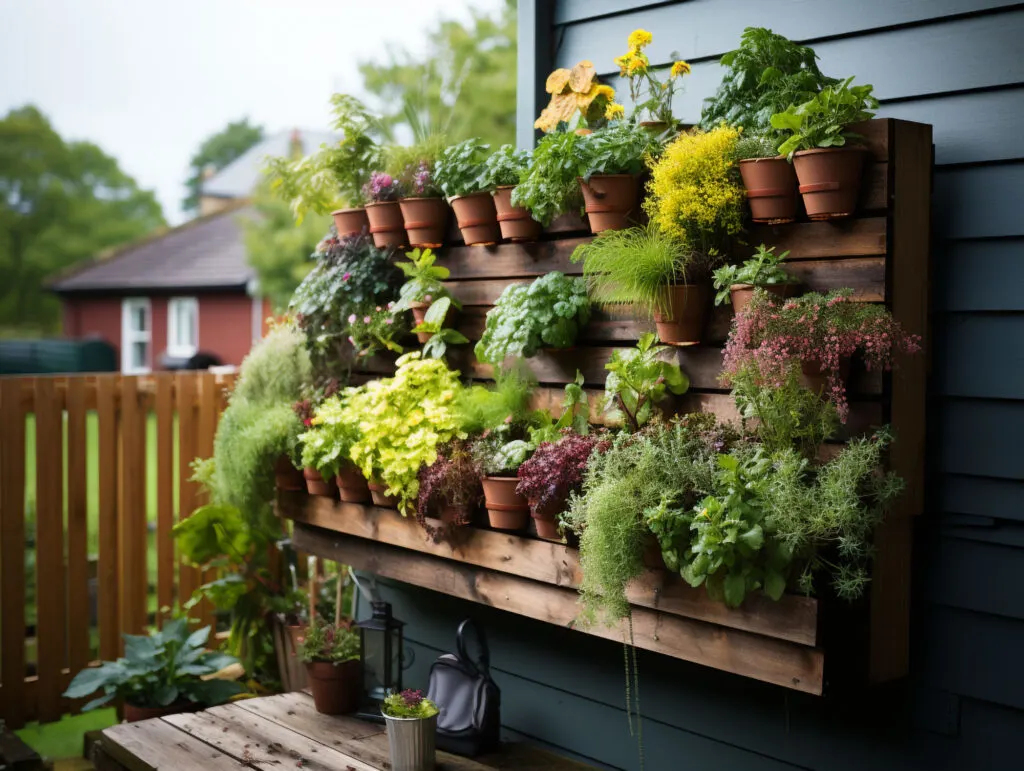
In addition to hanging the plants on the slats of the pallets, you can hang the whole pallet! Pallets make really unique wall gardens that can hold a variety of whatever you want to grow – herbs, vegetables, flowers, or all three!
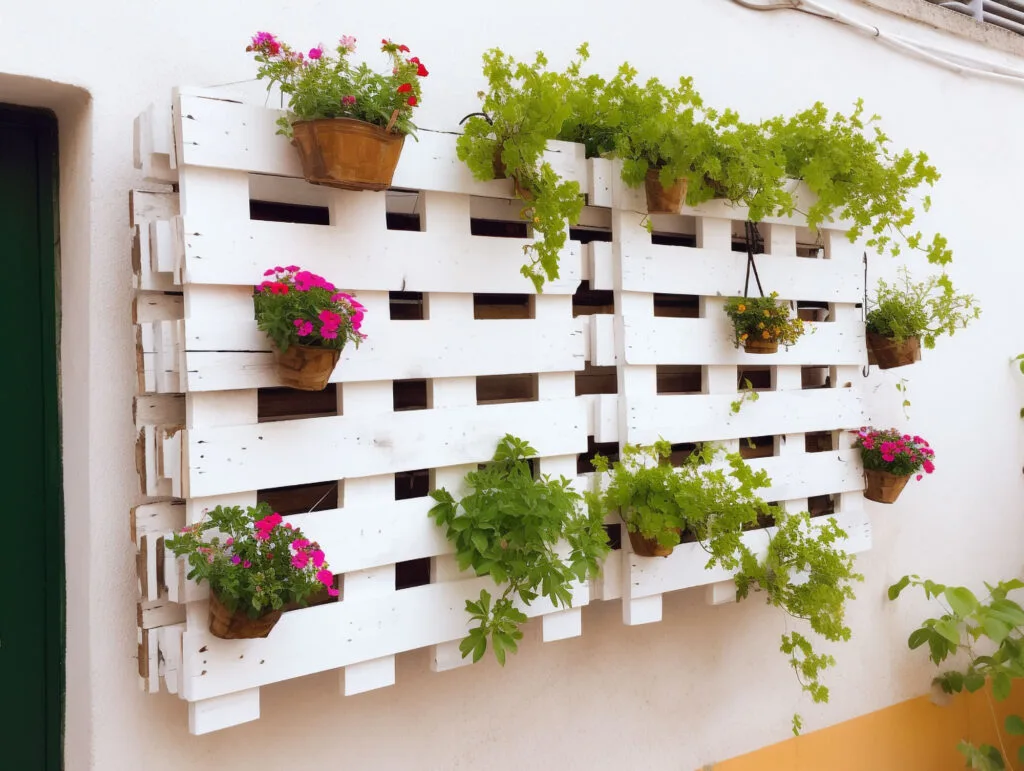
Pallets can be used in the garden in many other creative ways. For example, you can build a raised garden bed, a compost bin, or surround your entire garden with a pallet fence!
To sum it all up, vertical gardening, particularly using wood pallets, is an excellent solution for those with limited space. Not only is it an effective way to utilize upcycled pallets, but it’s also an easy way to add greenery and color to your living space.
Need more DIY inspiration? Here is a nice video tutorial from Chef Janie showing how to make a pallet vertical garden suitable for propping up against the side of your house or shed. All you need is the pallet, landscaping fabric, a staple gun, soil, and your choice of plants.
Whether you’re looking to grow a vegetable garden, a flower haven, or just want some rustic garden decor, wooden pallets provide a versatile, sustainable, and beautiful solution. With these ideas, you’ll have a lush and vibrant garden in no time!
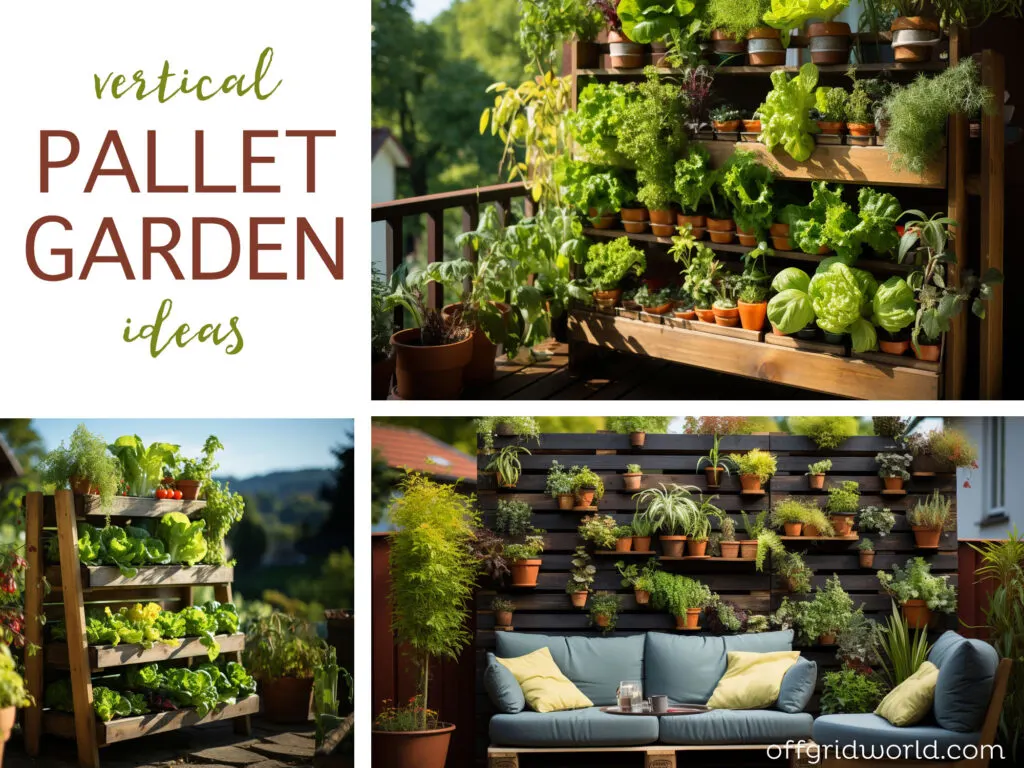

Build Raised Garden Beds Out of Almost Anything - Off Grid World
Tuesday 4th of June 2019
[…] Upcycle Old Pallets to Make Beautiful Vertical Gardens […]
10 Easy DIY Vertical Garden Ideas - Off Grid World
Monday 23rd of April 2018
[…] written about using pallets for vertical gardening before, and here’s another really neat pallet idea. These were seen by The Eclectic Ark at […]
10 Easy DIY Vertical Garden Ideas – The Prepper Dome
Wednesday 12th of July 2017
[…] written about using pallets for vertical gardening before, and here’s another really neat pallet idea. These were seen by The Eclectic Ark at […]
Paleţi reciclaţi în grădini verticale | TOTB.ro - Think Outside the Box
Thursday 20th of March 2014
[…] Sursa şi foto: Off Grid World […]